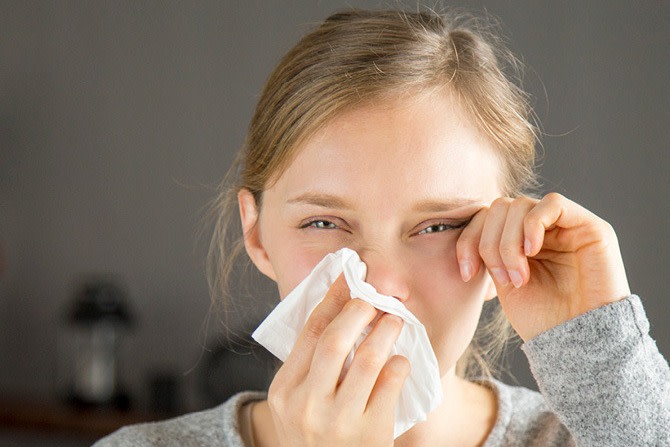Buy one pair of eyeglasses, get a second pair 50% off!
*Restrictions apply. Click here for details.
Understanding Your Eye Allergy Treatment Options

Red, itchy, or watery eyes aren’t just uncomfortable—they can be a sign of eye allergies. Recent advances in eye care have provided more ways to manage these symptoms and help you find relief.
If you experience eye allergies, you may notice redness, itching, or excessive tearing. In some cases, severe allergic reactions can become an ocular emergency, requiring prompt evaluation. Learn about common triggers and treatment strategies from the experts at eyecarecenter.
Common Triggers for Eye Allergies
Eye allergies can develop when your eyes are exposed to allergens such as pet dander, pollen, dust mites, or mold spores.
Some allergens are perennial, meaning they persist throughout the year and are often found indoors, including dust, pet hair, and indoor mold. Seasonal allergens, on the other hand, appear at specific times of the year and are commonly caused by pollen, ragweed, or grass.
When an allergen enters the body, histamine is released. This chemical causes the blood vessels in the eyes to swell, leading to redness, itching, and tearing—the key signs of allergic reactions.
Symptoms of Eye Allergies
Signs of allergic conjunctivitis can include:
Burning sensation
Itchy eyes
Redness
Puffy eyelids
Tearing
These symptoms can sometimes overlap with infections such as bacterial or viral conjunctivitis. An eye care professional can evaluate your eyes, review your medical history, and may recommend allergy testing to identify specific triggers and guide proper treatment.
Reducing Exposure to Eye Allergy Triggers
If you’ve been diagnosed with allergic conjunctivitis, minimizing contact with triggers can help reduce symptoms. Avoidance is often easier for indoor allergens like dust or pet dander, while seasonal allergens like pollen may require extra precautions. Limit exposure by staying indoors during high pollen periods, keeping windows closed, and using air conditioning instead of fresh air ventilation.
For mold allergies, spore counts can be higher during damp or rainy weather. Staying indoors during wet conditions and keeping leaves, compost, or damp debris away from your home can help.
To reduce dust mites, consider using washable bedding and curtains, or choosing furniture made from materials like leather or vinyl. Regularly wash bedding and clothing in hot water and steam clean carpets to minimize dust accumulation.
Effective Treatments for Eye Allergies
When avoiding allergens isn’t practical, managing symptoms, flushing out irritants, and preventing flare-ups becomes the focus. Start with basic home care and lubricating drops, incorporate over-the-counter solutions as needed, and consult your eye doctor if symptoms persist or worsen.
Home Care and Allergen Reduction
Reducing exposure to allergens at home is essential. Wash your face after outdoor activities, shower before bed, and regularly launder bedding and clothing. Avoid irritants like cigarette smoke, and if you wear contact lenses, keep your lenses and cases thoroughly clean. On high-pollen days, wearing glasses instead of contacts can help minimize allergens on your lenses.
Simple home remedies can also ease discomfort. A cool compress applied for 10–15 minutes can relieve itching and reduce swelling. Simply dampen a clean cloth with cold water, wring it out, and place it gently over your closed eyes.
Artificial Tears and Antihistamine Drops
Lubricating eye drops help rinse allergens from the eyes and soothe irritation or dryness. Preservative-free drops are ideal for frequent use. Antihistamine eye drops work quickly to relieve itching and decrease redness or tearing, usually applied once or twice daily depending on the product. For temporary redness without itching, decongestant “redness-relief” drops can shrink surface blood vessels for short-term relief.
Medications
Over-the-counter oral antihistamines can help when nasal or whole-body allergy symptoms accompany eye allergies. They may cause dryness, so pairing with artificial tears is recommended, and consult your eye doctor if dryness worsens.
For more persistent symptoms, prescription treatments are available. Mast cell stabilizers prevent histamine release in the eyes, and some prescription drops combine antihistamine and mast cell-stabilizing properties. Examples include Elestat® (epinastine), Zaditor® (ketotifen), and Patanol® (olopatadine hydrochloride), targeting itching, redness, burning, and tearing. In severe cases, steroid eye drops may be prescribed to reduce inflammation and swelling, but these should always be used under an eye doctor’s supervision due to potential risks such as increased eye pressure or infection.
Other Eye Conditions with Similar Symptoms
Red, itchy, or watery eyes are not always caused by allergies. An eye care professional can help determine the underlying cause and recommend appropriate treatment. Conditions that can mimic allergic conjunctivitis include:
Allergic Rhinitis: Commonly known as hay fever, this allergy affects the nose and throat, causing sneezing, congestion, runny or itchy nose, and sometimes a scratchy throat.
Dry Eye: Inadequate tear production or poor tear quality can lead to irritation, inflammation, and damage to the eye surface.
Pink Eye: Inflammation of the thin membrane covering the eyelid and eye surface can result from bacteria, viruses, or allergies. In infants, a blocked tear duct may also be the cause.
If you experience any of these symptoms, contact an eye care provider at eyecarecenter for proper evaluation and treatment.
Treat Eye Allergies at eyecarecenter
With the right approach, managing eye allergies can become straightforward. Modern treatments make it possible to ease itching, redness, and discomfort while protecting your eyes. If you notice signs of allergic conjunctivitis, schedule a visit with an eyecarecenter provider to develop a personalized plan. Find a convenient eyecarecenter location near you and book your eye exam today.
